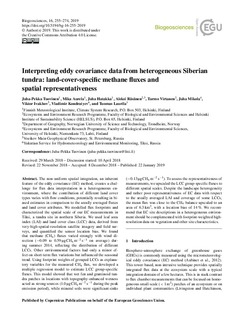| dc.contributor.author | Tuovinen, Juha Pekka | |
| dc.contributor.author | Aurela, Mika | |
| dc.contributor.author | Hatakka, Juha | |
| dc.contributor.author | Räsänen, Tuomas Aleksi | |
| dc.contributor.author | Virtanen, Tarmo | |
| dc.contributor.author | Mikola, Juha | |
| dc.contributor.author | Ivakhov, Viktor | |
| dc.contributor.author | Kondratyev, Vladimir | |
| dc.contributor.author | Laurila, Tuomas | |
| dc.date.accessioned | 2020-02-10T08:06:47Z | |
| dc.date.available | 2020-02-10T08:06:47Z | |
| dc.date.created | 2019-09-20T11:20:51Z | |
| dc.date.issued | 2019 | |
| dc.identifier.citation | Biogeosciences. 2019, 16 (2), 255-274. | nb_NO |
| dc.identifier.issn | 1726-4170 | |
| dc.identifier.uri | http://hdl.handle.net/11250/2640567 | |
| dc.description.abstract | The non-uniform spatial integration, an inherent feature of the eddy covariance (EC) method, creates a challenge for flux data interpretation in a heterogeneous environment, where the contribution of different land cover types varies with flow conditions, potentially resulting in biased estimates in comparison to the areally averaged fluxes and land cover attributes. We modelled flux footprints and characterized the spatial scale of our EC measurements in Tiksi, a tundra site in northern Siberia. We used leaf area index (LAI) and land cover class (LCC) data, derived from very-high-spatial-resolution satellite imagery and field surveys, and quantified the sensor location bias. We found that methane (CH4) fluxes varied strongly with wind direction (−0.09 to 0.59 µgCH4m−2s−1 on average) during summer 2014, reflecting the distribution of different LCCs. Other environmental factors had only a minor effect on short-term flux variations but influenced the seasonal trend. Using footprint weights of grouped LCCs as explanatory variables for the measured CH4 flux, we developed a multiple regression model to estimate LCC group-specific fluxes. This model showed that wet fen and graminoid tundra patches in locations with topography-enhanced wetness acted as strong sources (1.0 µgCH4m−2s−1 during the peak emission period), while mineral soils were significant sinks (−0.13 µgCH4m−2s−1). To assess the representativeness of measurements, we upscaled the LCC group-specific fluxes to different spatial scales. Despite the landscape heterogeneity and rather poor representativeness of EC data with respect to the areally averaged LAI and coverage of some LCCs, the mean flux was close to the CH4 balance upscaled to an area of 6.3 km2, with a location bias of 14 %. We recommend that EC site descriptions in a heterogeneous environment should be complemented with footprint-weighted high-resolution data on vegetation and other site characteristics. | nb_NO |
| dc.language.iso | eng | nb_NO |
| dc.publisher | European Geosciences Union | nb_NO |
| dc.rights | Navngivelse 4.0 Internasjonal | * |
| dc.rights.uri | http://creativecommons.org/licenses/by/4.0/deed.no | * |
| dc.title | Interpreting eddy covariance data from heterogeneous Siberian tundra: Land-cover-specific methane fluxes and spatial representativeness | nb_NO |
| dc.type | Journal article | nb_NO |
| dc.type | Peer reviewed | nb_NO |
| dc.description.version | publishedVersion | nb_NO |
| dc.source.pagenumber | 255-274 | nb_NO |
| dc.source.volume | 16 | nb_NO |
| dc.source.journal | Biogeosciences | nb_NO |
| dc.source.issue | 2 | nb_NO |
| dc.identifier.doi | 10.5194/bg-16-255-2019 | |
| dc.identifier.cristin | 1727134 | |
| dc.description.localcode | © Author(s) 2019. This work is distributed under the Creative Commons Attribution 4.0 License. | nb_NO |
| cristin.unitcode | 194,67,10,0 | |
| cristin.unitname | Institutt for geografi | |
| cristin.ispublished | true | |
| cristin.fulltext | original | |
| cristin.qualitycode | 1 | |

